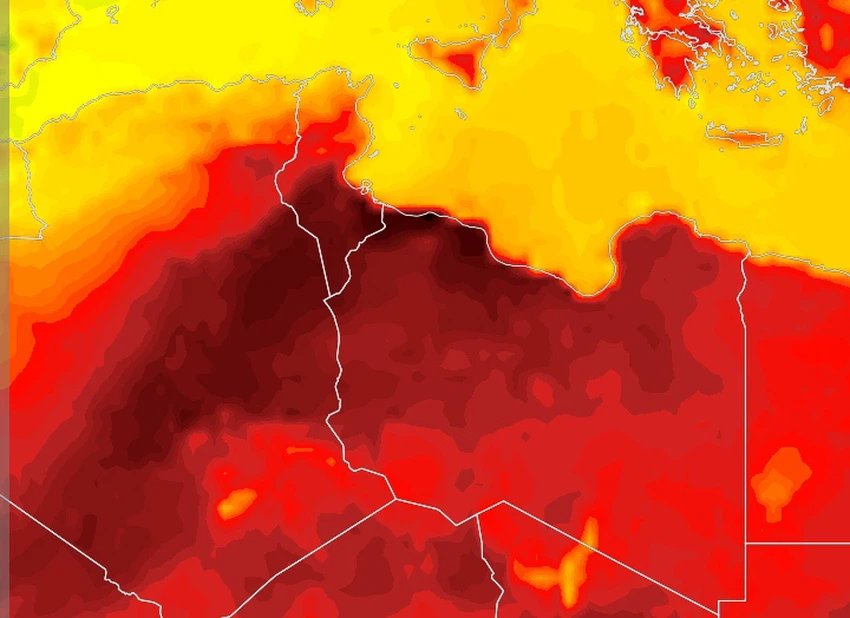The Arab Maghreb | An intense heat wave is expected next week, during which temperatures will reach nearly 50 degrees Celsius in Libya and Tunisia
Arabia Weather - Weather forecasters at the Arabia Weather Center said that the latest outputs received from the so-called computer simulation indicate that Libya and Tunisia will be affected by a record heat wave during the next week that will inflame the atmosphere with extremely high temperatures, as some computer outputs sense that temperatures are approaching the 50 Celsius mark in Some areas in light of the two countries being affected by the so-called Fohn wind phenomenon.
Computer simulation: A fiery air mass that begins on Saturday and continues for several days with extremely hot conditions.
Weather forecasters at the Arabia Weather Center said that the maps specialized in tracking the movement of air masses indicate the rush of an air mass with temperatures lower than the average for Algeria, which pushes another hot air mass from deep in the African desert towards Tunisia and Libya as an adverse reaction, starting on Saturday and for several days coinciding with the control of... A strong atmospheric rise in the upper atmosphere fuels the so-called heat dome over both countries.
Thus, meteorological experts expected that the country would begin to be affected by the intense heat wave in the coming days. Therefore, there will be a clear rise in temperatures, and the weather will be extremely hot and exhausting in various regions of Tunisia and Libya, with temperatures expected to be around the mid-forties Celsius to higher than that, and the value of the maximum temperature varies depending on The region (while the coastal areas are also vulnerable to scorching temperatures as a result of their exposure to hot, desert-sourced air currents, they are also not far from hot climates due to high levels of humidity that increase the sensation of heat)
Arab weather specialists: Fuhan winds inflame the atmosphere with temperatures that may reach 50 degrees Celsius, and most eyes turn to the Jaffara plain.
The weather specialists at the Arab Weather Center are monitoring the impact of Tunisia and Algeria on the so-called Fohn winds, which is a dynamic process that results from the heating and drying of the air as it descends from the mountains into the valleys, and as a result of the winds coming from very hot or scorching hot southern desert sources and passing over the mountain ranges, especially the Western Mountain. As it slopes towards the Jaffara Plain (extending from southern Tunisia to the west to northern Libya), it is expected that a process of intense air heating will occur, which will raise the temperatures in and around the Jaffara Plain to values reaching 48-49 degrees Celsius in the middle and end of next week. Thus, it will have touched 50 Celsius in these areas due to... Fohn phenomenon.
![]()
For experts and specialists: The thermal dome and the Foehn winds are two sides of the same coin and enhance temperature rise side by side.
The forecasters of the climate section in ArabiaWeather concluded that the heat dome is considered one of the most prominent causes of intense heat in the world, and it is a climate phenomenon that results from an area of high air pressure in the high layers of the atmosphere that works to heat the air in the lower layers of the atmosphere due to a dynamic process called (heating under pressure). Where, with the compression of air in a specific area under the influence of an air ridge in the high layers of the atmosphere, a hot, surface air mass is created, the intensity of which varies according to the region and the intensity of the air ridge, and also according to the period of its formation during the year.
The air riser traps the hot air like a cover or cover on a boiling pot, and as the hot air expands vertically in the atmosphere, the high pressure pushes it toward the ground again, and the air is compressed again under the area of high atmospheric pressure, causing it to gain more heat. This is scientifically known as underheating. the pressure.
As for the Foehn phenomenon or Foehn winds, it is simply the descent of winds from the tops of high mountains towards the slopes and low valleys, where rapid heating of the air occurs. For example, the effect of the Foehn winds is clear, which causes self-heating of the air that enhances the scorching temperatures.
God knows.
Arabia Weather App
Download the app to receive weather notifications and more..




